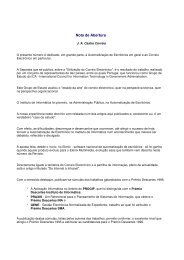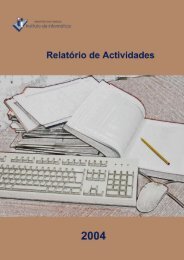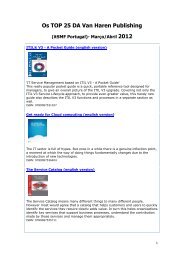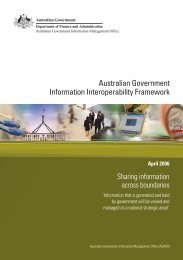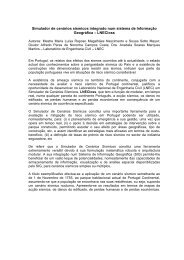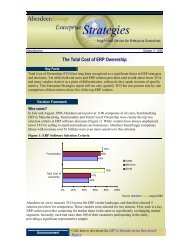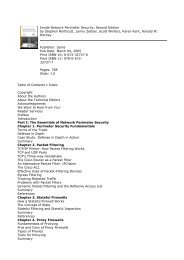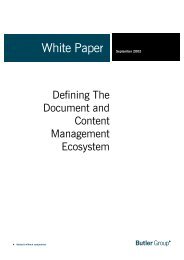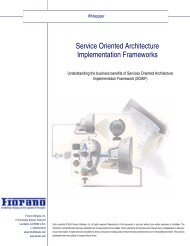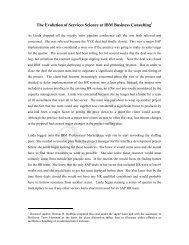OECD Peer Review of E-Government in Denmark - ePractice.eu
OECD Peer Review of E-Government in Denmark - ePractice.eu
OECD Peer Review of E-Government in Denmark - ePractice.eu
You also want an ePaper? Increase the reach of your titles
YUMPU automatically turns print PDFs into web optimized ePapers that Google loves.
such a framework be designed; and 3) how its use could be ensured These questions were answered<br />
<strong>in</strong> mid-2003 with the MVTU’s publication <strong>of</strong> the White Paper on Enterprise Architecture.<br />
The white paper, developed by the Work<strong>in</strong>g Group on IT Architecture established to report to the<br />
MVTU’s Co-ord<strong>in</strong>at<strong>in</strong>g Information Committee, noted the need to remove technological barriers to<br />
e-government across the public sector. It confirmed that a significant challenge <strong>in</strong> this area was the<br />
lack <strong>of</strong> an enterprise architecture (<strong>in</strong>clud<strong>in</strong>g common standards for data exchange) to serve as the basis<br />
for the development <strong>of</strong> common ICT solutions and <strong>in</strong>frastructure.<br />
The white paper conta<strong>in</strong>ed three ma<strong>in</strong> recommendations:<br />
• <strong>Government</strong> organisations should take more active responsibility for enterprise architecture.<br />
• A common enterprise architecture framework should be established for plann<strong>in</strong>g public<br />
sector IT systems, especially to ensure system <strong>in</strong>teroperability.<br />
• There should be a major effort to spread knowledge and develop competencies <strong>in</strong> enterprise<br />
architecture, especially <strong>in</strong> relation to cross-organisation <strong>in</strong>itiatives.<br />
It went on to recommend that a common enterprise architecture framework should <strong>in</strong>clude:<br />
• Co-ord<strong>in</strong>ation mechanisms, <strong>in</strong>clud<strong>in</strong>g the appo<strong>in</strong>tment <strong>of</strong> an enterprise architecture<br />
committee report<strong>in</strong>g to the Co-ord<strong>in</strong>at<strong>in</strong>g Information Committee.<br />
• A common methodology (cover<strong>in</strong>g processes, concepts and specification <strong>of</strong> standards) for<br />
development <strong>of</strong> enterprise architecture.<br />
• Common choices and pr<strong>in</strong>ciples with regard to technical standards, ICT <strong>in</strong>frastructure etc.<br />
(to be codified as the “Reference Pr<strong>of</strong>ile”).<br />
• Common tools to facilitate use <strong>of</strong> the architecture, such as databases and libraries <strong>of</strong> contract<br />
models, process specifications, data def<strong>in</strong>itions, s<strong>of</strong>tware “components”, and specifications<br />
for <strong>in</strong>frastructure solutions.<br />
As a result <strong>of</strong> these recommendations, the goal <strong>of</strong> bas<strong>in</strong>g public sector use <strong>of</strong> ICT on a common<br />
design framework was <strong>in</strong>corporated <strong>in</strong>to both government ICT policy and Project e-<strong>Government</strong>, with<br />
significant resources be<strong>in</strong>g put <strong>in</strong>to achiev<strong>in</strong>g this goal by the National IT and Telecom Agency<br />
(ITST). As well as lead<strong>in</strong>g processes to develop the wide range <strong>of</strong> standards required to implement the<br />
enterprise architecture, the ITST has worked with the Digital Task Force to communicate its grow<strong>in</strong>g<br />
knowledge and expertise <strong>in</strong> enterprise architecture to participants <strong>in</strong> a number <strong>of</strong> e-government<br />
projects. Experience ga<strong>in</strong>ed from these projects has then been fed back <strong>in</strong>to the ITST’s ongo<strong>in</strong>g<br />
development <strong>of</strong> the enterprise architecture (especially the Reference Pr<strong>of</strong>ile or “e-government<br />
<strong>in</strong>teroperability framework” – see below), and <strong>in</strong>to handbooks and guidel<strong>in</strong>es be<strong>in</strong>g produced to assist<br />
organisations <strong>in</strong> implement<strong>in</strong>g it <strong>in</strong> their own applications and systems.<br />
The fundamental purpose <strong>of</strong> the enterprise architecture is to harmonise <strong>in</strong>dividual organisations’<br />
decisions about ICT <strong>in</strong> order to achieve <strong>in</strong>teroperability <strong>of</strong> government <strong>in</strong>formation and systems – a<br />
precondition to creat<strong>in</strong>g the more efficient, coherent and user-centric public sector targeted by the<br />
Danish e-government vision. In addition to support<strong>in</strong>g delivery <strong>of</strong> better services, the Danish<br />
enterprise architecture is expected to enable optimization <strong>of</strong> the value <strong>of</strong> government ICT <strong>in</strong>vestments,<br />
104



